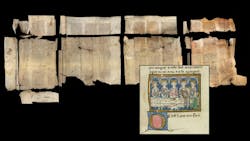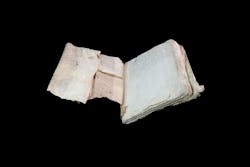U.K. team unlocks medieval mysteries via optics
Medieval tales can be mystical and captivating, but not always based on actual events or people. Some are, though, including those involving Merlin and King Arthur. And now, a team at the University of Cambridge, alongside the Cambridge University Library’s Cultural Heritage Imaging Laboratory, are working to uncover the mysteries and restore ancient manuscripts (see video).
The team is using a blend of multispectral imaging and 3D modeling to recover lost text in a 13th century manuscript fragment they discovered hidden in the binding of a 16th century archival register. It’s part of the Lancelot-Grail set of books and the Suite Vulgate du Merlin, a French-language sequel to the legend of King Arthur. According to Maciej M Pawlikowski, head of the Cultural Heritage Imaging Laboratory at Cambridge University Library, there are fewer than 40 manuscripts left from this set. Each one was individually handwritten by medieval scribes.
“This latest discovery has been identified as having been written between 1275 and 1315,” Pawlikowski says.
Pawlikowski's team has been in the process of digitizing manuscripts and other documents and books with the help of staff photographer Blazej Mikula.
“He retrieved some of the lost text that was hidden between the folds of the parchment using a set of mirrors, a prism, specialized lenses, and a phone,” Pawlikowski says. “With multispectral imaging, we recovered all of the lost text from the middle section of the front of the page, which was most likely rubbed off by a belt of some kind holding the binding.”
The team also identified that two kinds of blue pigments were used—azurite and indigo—in the original manuscript. They then created a multispectral false color composite image to map those pigments across all of the pages.
Ancient artifacts meet modern technology
With multispectral imaging, the team was able to enhance the details and readability of the manuscript’s text. This technique was paired with CT scanning to capture photos of each section of the fragment, which were then combined to create a 3D model. This allows the team to unfold, digitize, and study the manuscript without dismantling or harming it.
“Multispectral imaging brings incredibly refreshing and exciting perspective to Cultural Heritage artifacts since it is revealing otherwise invisible features,” Pawlikowski says. “It is about creating another dimension of the object that will then exist in its own right.”
The team’s multispectral imaging approach involves capturing manuscript fragments in various wavelengths of light, from UV to infrared. The resulting high-resolution images enhanced the readability of the text and annotations in the book margins. And thanks to geospatial software, details within the manuscripts that are invisible to the naked eye became prominent.
Pawlikowski says the work was a solid group effort. “The process itself is a dialogue between researcher, photographer, conservator, and heritage scientist,” he says, “When it comes to more complex research questions, none of those methods exist within a silo, and to interpret the results well you need to bring all those points of view into one room.”
The team got some assistance from the University’s zoology department, as well, by way of an x-ray scanner that’s typically used to inspect fossils and skeletons. This virtually penetrated the layers of manuscript parchment and helped uncover hidden structures in the binding.
Using industrial scanning techniques, Pawlikowski says the team could create highly detailed virtual models of the manuscript fragments and their bindings. The industrial scanning technique captured hundreds of photos of each section of the fragment to ultimately assemble a 3D model.
With the combined method approach, characteristics such as creases—hidden under folds or stitched into the book bindings—became visible in remarkable detail.
Ongoing discoveries
There is “more to explore within the Merlin fragment itself,” Pawlikowski says. “We just proved that this multidimensional and complex research is possible.”
The Cambridge library currently holds about 9 million books in its collection. About 2.5 million are special collection items, meaning they’re each unique in some way.
“I am sure we will find some more mysterious fragments we will need to shed some light on,” Pawlikowski says. “Inevitably, through studying those works we learn more about ourselves as humans and curiosity is what makes us so.”
About the Author
Justine Murphy
Multimedia Director, Digital Infrastructure
Justine Murphy is the multimedia director for Endeavor Business Media's Digital Infrastructure Group. She is a multiple award-winning writer and editor with more 20 years of experience in newspaper publishing as well as public relations, marketing, and communications. For nearly 10 years, she has covered all facets of the optics and photonics industry as an editor, writer, web news anchor, and podcast host for an internationally reaching magazine publishing company. Her work has earned accolades from the New England Press Association as well as the SIIA/Jesse H. Neal Awards. She received a B.A. from the Massachusetts College of Liberal Arts.



